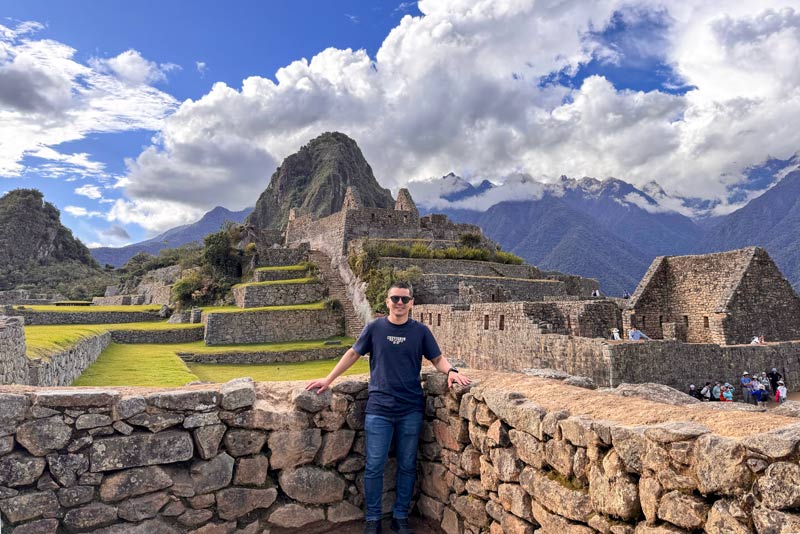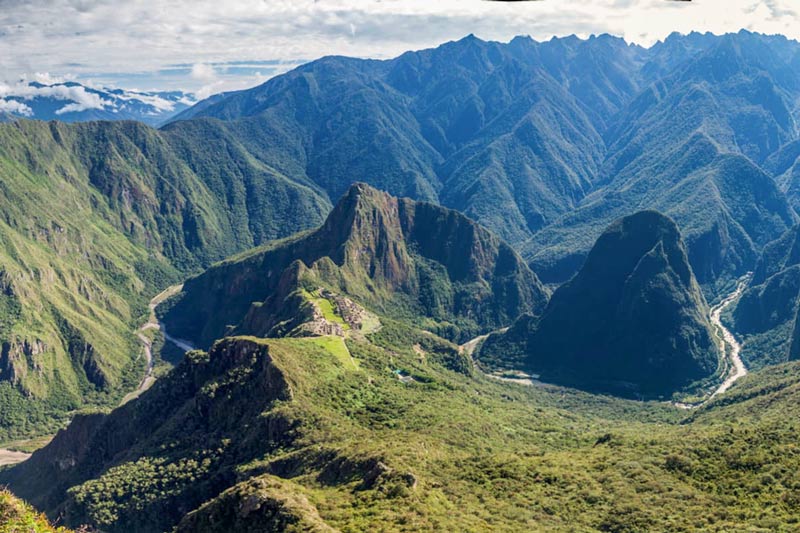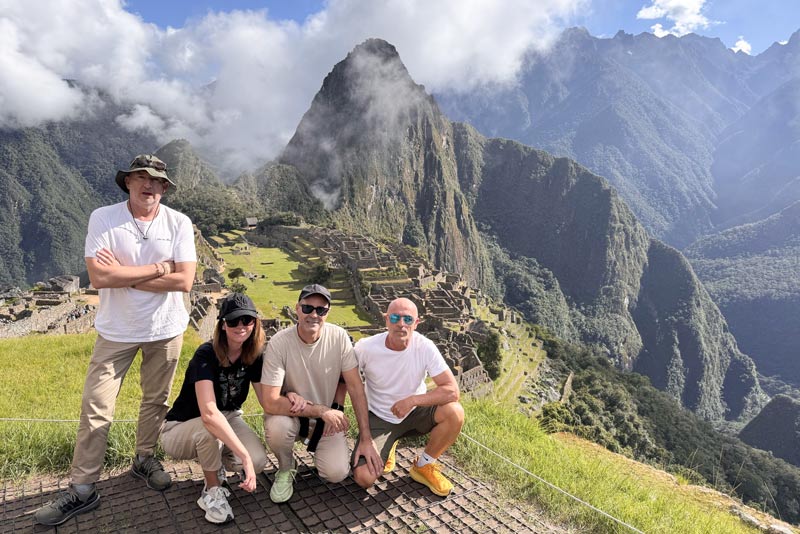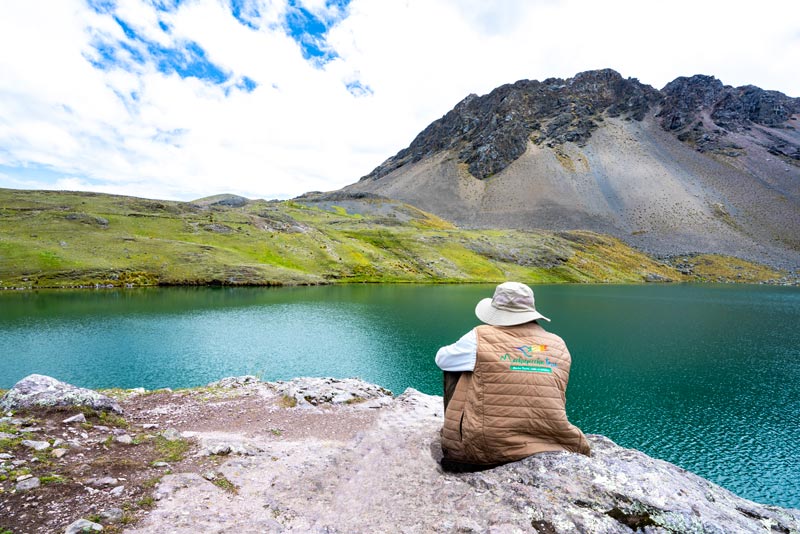Ecotourism in Machu Picchu: tips for a responsible trip to the wonder of the world
Machu Picchu is a must-see destination, at least once in a lifetime. Nestled in the mountains and surrounded by lush vegetation, it’s an archaeological site that preserves a perfect connection with the surrounding nature. Since Machu Picchu was declared a Wonder of the World, the number of visitors has multiplied daily, which is why complying with conservation measures is so important. Discover how to help preserve the historic Inca sanctuary and enjoy a trip practicing ecotourism in Machu Picchu.
- Machu Picchu, an ecological destination
- How to practice ecotourism in Machu Picchu?
- Ecotourism experiences in Cusco
- Tips for responsible travel
- Frequently Asked Questions
Machu Picchu, an ecological destination
The Inca citadel of Machu Picchu was built in the 15th century by the Inca Pachacútec. Its location was due to the geographical location, surrounded by a rich biodiversity, the presence of numerous indented “apus” mountains, and the presence of the Urubamba River. These details were always key to the Inca culture, given that for them, the earth, “pachamama,” was a deity, to whom reciprocity was owed for all the well-being it brings (from the crops to the resources that can be found there).
That’s why all of their constructions are in perfect symbiosis with the surrounding nature, seeking to alter the ecosystem as little as possible. You can see this characteristic not only in Machu Picchu, but also in Ollantaytambo, Pisac, Chinchero, Sacsayhuamán, and many other destinations throughout the ancient Tahuantinsuyu empire.
In modern times, preserving these ecosystems is more difficult, given that archaeological sites are designated for tourism, and everyone wants to see the wonder and magic of Machu Picchu. The challenge lies with the Ministry of Culture, which implements conservation measures and reduces the environmental impact; although it also depends on each visitor, seeking to protect the environment in which the Inca citadel lies.
Machu Picchu is designed to be an ecotourism destination, from the usual way of reaching the archaeological site (on an eco-friendly bus) to the limited access allowed (5,600 people per day). You can also access it on foot; many of the adventures are focused on discovering the site’s biodiversity without unduly disturbing the ecosystem, offering you more authentic and responsible experiences.
How to practice ecotourism in Machu Picchu?
If you’re planning a trip to Machu Picchu and want to minimize your impact by practicing ecotourism, we’ll offer some recommendations that will enhance your travel experience. (Eco-friendly and sustainable destinations in Cusco)
Avoid touching Inca buildings
We know it can be tempting to touch the fascinating stone structures, but it’s a bad idea. The residue from lotions, sunscreens, and insect repellents on our hands contains chemicals that can damage the rock’s surface. Plus, thousands of people visit Machu Picchu every day; imagine the wear and tear that would occur if each of them dragged their fingers along the city’s surfaces.
Take your waste
Do not throw anything away on the Machu Picchu grounds. We understand that you may need to bring water and snacks with you, and these are usually in disposable packaging. Therefore, you should also designate a space to store your waste. This way, we preserve the environment surrounding the archaeological site.
Choose sustainable transportation
Choose to walk or use a bicycle during your tours. Fortunately, to ascend to Machu Picchu, there’s only one option: taking an eco-friendly bus, which greatly reduces the impact caused by the thousands of people who visit the historic sanctuary daily.
Consume local products
Agricultural production is abundant throughout the Sacred Valley, which is also home to Machu Picchu. When choosing your food, try to consume local products. You’ll not only be supporting the local economy, but also enjoying healthier meals.
Avoid noise pollution
Machu Picchu preserves an ecosystem rich in native flora and fauna, which can be disturbed by loud noises. This also impacts the tranquility of visitors to the archaeological site, as the tranquility of being surrounded by such incredible landscapes is one of the site’s main attractions.
Avoid disturbing llamas and animals
Despite being very cute animals, keep in mind that llamas often spit when they feel uncomfortable, and they have even been known to bite if threatened. The archaeological sanctuary is home to many animals, from llamas to insects. Be sure to respect their environment. If you are accompanied by a guide, you can ask for assistance if you want a photo with the llamas of Machu Picchu.
Bring reusable water bottles
All trash (including plastic drink bottles) must be sent from Machu Picchu to Cusco by train. Help reduce waste by using reusable bottles. Keep in mind that the millions of visitors to Machu Picchu each year generate tons of trash.
Do not buy products made from animals
Machu Picchu is home to dozens of threatened or protected plant and animal species, including bears, jaguars, monkeys, and birds. Never purchase a product made from an endangered plant or animal species.
Buy local crafts
Andean culture boasts beautiful and impressive handcrafted products, whose craftsmanship preserves techniques that date back long before the Inca era. By purchasing one of these products, you’re taking a part of the destination with you on your visit. You’ll also be supporting the local economy, ensuring the continued preservation of this ancestral knowledge.
Visit alternative destinations
The city of Cusco is surrounded by beautiful tourist spots that you can explore without the crowds at the more popular sites. Among the most recommended are Choquequirao, Lares Valley, Huchuy Qosqo, and Ausangate.
Ecotourism experiences in Cusco
Searching for ecotourism experiences and discovering breathtaking places is possible during your trip to Cusco. The region boasts not only archaeological sites but also natural destinations that can add even more richness to your trip. Visit each of the following destinations to experience an unforgettable experience, in addition to practicing ecotourism.
Choquequirao
The Choquequirao archaeological site is one of the most impressive Inca structures, although it’s not as popular because it typically requires a four-day hike. It’s a much more immersive and authentic experience, given the low number of people who walk its historic trails.
Upon arrival, you’ll understand why Choquequirao is often referred to as Machu Picchu’s younger brother, as it’s also a vast archaeological site on a mountaintop. Throughout the hike, you’ll be surrounded by landscapes brimming with biodiversity, and upon arrival, you’ll discover enigmatic buildings steeped in history.
Lares Valley
Lares is a town located in the province of Calca, known for its stunning landscapes surrounded by mountains and snow-capped peaks such as Verónica, Sawasiray, Pitusiray, and Chicón. Adventures here involve exploratory hikes, usually leading to Ollantaytambo, where you can decide whether to return to Cusco or embark on a longer adventure to Machu Picchu.
During your visit, you’ll discover Andean communities steeped in tradition, rich flora typical of high Andean regions, and numerous animals. Lares also boasts hot springs amidst sweeping landscapes, perfect for relaxing.
Huchuy Qosqo
It is an archaeological site located on a mountaintop in the town of Lamay, part of the Sacred Valley of the Incas. It’s a place where we can see adobe and stone dwellings and warehouses, alongside large natural fields and water sources (many of which are still functioning today). One of Huchuy Qosqo main attractions is its landscape, given that its altitude (3,600 meters above sea level) allows us to view the Sacred Valley in all its splendor.
There are several routes to explore this magical archaeological site, such as the route through Tambomachay, the route through Chinchero, and the route from Lamay. Each route involves hiking, but they are well worth the effort to explore this archaeological site hidden in the mountains.
Ausangate
The snow-capped Ausangate Mountain is the highest mountain in Cusco, reaching 6,484 meters above sea level and forming part of the Vilcanota mountain range. Visiting it involves long hikes, generally lasting between four and five days, although there are also ways to visit it for just one day in more remote areas, such as the Seven Lagoons Tour.
During your hike up Ausangate Mountain, you’ll discover its biodiversity, including glaciers, lagoons, and streams, along with a wealth of local flora and fauna. Another attraction is its local culture, as you’ll visit communities that preserve many Andean traditions along the way.
| Tourist destinations in Cusco for ecotourism | |||||
|---|---|---|---|---|---|
| Destination | Type of experience | Average duration | Difficulty level | Main feature | Tourist influx |
| Ausangate | High mountain hike alongside lagoons and glaciers | 4-6 days (full route) | High (altitudes over 5,000 meters above sea level) | Andean landscapes with snow-capped mountains and many colorful lagoons | Low |
| Huchuy Qosqo | Archaeological route with views of the Sacred Valley | 1-2 days (full route) | Medium (ideal for occasional walkers) | Uncrowded archaeological site next to impressive natural viewpoints | Low |
| Lares Valley | Cultural walk alongside Andean communities and landscapes | 3-4 days (full route) | Medium (long but accessible walks) | Hiking experience and experiential tourism practice alongside communities and hot springs | Average |
| Choquequirao | Archaeological route through the jungle eyebrow areas | 4-5 days (full route) | High (demanding hike with large slopes) | A large and little-visited archaeological site, an opportunity to discover it before it becomes overcrowded. | Low |
Tips for responsible travel
- Choose sustainable transportation when getting around, especially on short trips. Walking or renting bicycles is the best option if you’re in Cusco.
- Try to reduce your carbon footprint by traveling light and consciously, and choose to use biodegradable products wherever possible.
- Avoid using single-use plastics; it’s recommended to use reusable bottles and cloth bags.
- Don’t litter or disrupt the biodiversity of the places you visit; respecting nature is paramount.
- Learn and respect local customs, much of what you see can be quite surprising.
- Stay in local homes or eco-lodges, this way you can support the local economy.
- If you’re going to buy handicrafts, look for authentic, local ones; they’re the best souvenirs you can take home.
- Eat local products, look for restaurants that use ingredients from the region.
- Join community projects or volunteer; these experiences will give greater meaning to your trip.
- Choose alternative tourism destinations, Ausangate, Huchuy Qosqo, Lares and Choquequirao are your best option.
- Your behavior inspires other travelers, leaving the place better than you found it.
Frequently Asked Questions
1) How to practice ecotourism in Machu Picchu?
Visiting Machu Picchu while reducing your impact is possible by choosing alternative routes, leaving no waste along the way, not disturbing biodiversity, and avoiding touching Inca structures.
2) Why is Machu Picchu an ecological destination?
Given that it’s surrounded by nature, it coexists in symbiosis with the environment. Furthermore, many of the measures taken to avoid excessively disrupting the ecosystem are key to providing an authentic experience (eco-friendly buses, capacity limits, and route plans).
3) What is the best time to visit Machu Picchu sustainably?
During the regular season, it’s the best time to visit Machu Picchu sustainably. From January to March, fewer people visit the archaeological site, resulting in a lower environmental impact.
4) What alternative routes are there to get to Machu Picchu without contributing to mass tourism?
You can visit Machu Picchu via the Lares Trek, the Hydroelectric Power Station, and the Inca Trail. You can also take the less popular routes to the archaeological site, such as the Inca Bridge, Intipunku, and the Great Cave.
5) What is the impact of mass tourism on Machu Picchu?
Mass tourism in Machu Picchu can affect the surrounding ecosystem, especially as it is home to many plants and animals. Over time, it also affects the buildings and roads within the Inca citadel.
6) How many visitors are allowed per day in Machu Picchu?
Machu Picchu has a capacity of 5,600 people per day, enough to seek to preserve this wonder of the world.
7) What are the best places for ecotourism in Cusco?
The best ecotourism destinations in Cusco are the Choquequirao archaeological site, the Lares Valley, the Huchuy Qosqo archaeological park, and hikes on the Ausangate snow-capped mountain.
8) What is the experience like in Choquequirao?
Choquequirao is a vast archaeological site in the mountains of the Santa Teresa district. It’s an immersive and authentic experience with few visitors. It involves a strenuous hike, but the destination is almost as stunning as Machu Picchu.
9) What is the experience like in the Lares Valley?
The Lares Valley offers a cultural and experiential experience alongside local communities and Andean landscapes. You can also visit its famous hot springs for a relaxing break.
10) What is the experience like in Huchuy Qosqo?
The Huchuy Qosqo experience is shorter; depending on the route you choose, it can take one or two days. Throughout the journey, you’ll be surrounded by the stunning landscapes of the Sacred Valley, along with a little-known Inca archaeological site.
Advice from people who have been there
 By: Gabriel H.
By: Gabriel H.“The jewel of Peru“
“Machu Picchu is a site that thrills as soon as you see it. Walking among its temples and terraces surrounded by mountains is a unique experience. It is a place that everyone should visit once in a lifetime.“
By Ticket Machu Picchu – Last updated, August 19, 2025



